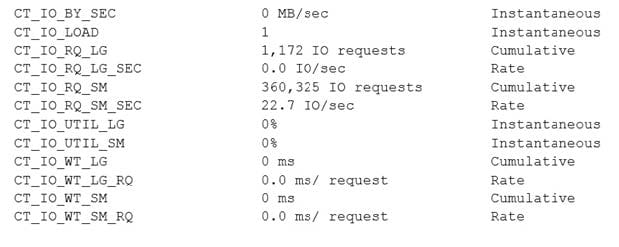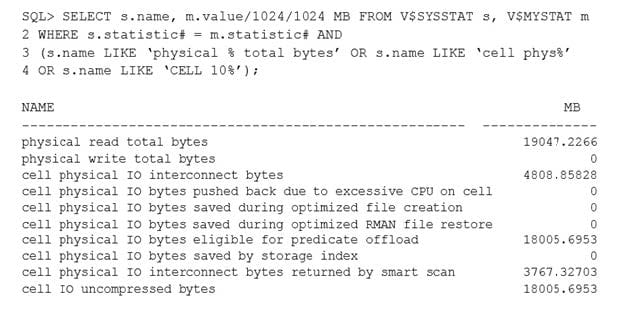Exam Details
Exam Code
:1Z0-070Exam Name
:Oracle Exadata X5 AdministrationCertification
:Oracle CertificationsVendor
:OracleTotal Questions
:103 Q&AsLast Updated
:Mar 29, 2025
Oracle Oracle Certifications 1Z0-070 Questions & Answers
-
Question 81:
Which two statements are true about RMAN incremental level-1 backups for a database running on an X5 Database Machine?
A. Block Change tracking (BCT) is not needed for databases in an X5 Database Machine, because ASM automatically does block change tracking when diskgroups are built from griddisks.
B. cellsrv filters blocks and returns only those that have changed since the last backup, for databases in archivelogmode.
C. cellsrv returns all blocks that have been or might have been changed since the last backup, and RMAN filters the blocks that do not require backup.
D. cellsrv filters blocks and returns only those that have changed since the last backup, for databases in noarchivelogmode.
E. Block Change Tracking (BCT) is not needed for databases in an X5 Database Machine, because change tracking is done by cellsrv.
-
Question 82:
Which components of an Exadata storage server image, if updated, may require that a patch also be applied to the database servers in an Exadata X6 Database Machine?
A. Linux operating system on the storage server
B. InfiniBand HCA firmware on the storage server
C. Storage server hard disk device drivers
D. Storage server flash device drivers
-
Question 83:
Which two statements are true about the use of DBFS, ACFS, and external file systems and components in an X5 Database Machine environment?
A. ACFS uses storage in a database on the database machine
B. DBFS supports file system snapshots.
C. ACFS supports file system snapshots.
D. Storage Area Network (SAN) –based file systems may be accessed directly from the storage servers in a database machine.
E. Oracle Sun ZFS Storage Appliance-based files are not automatically protected by Data Guard.
-
Question 84:
Which two are true about sparse griddisks and their use in disk groups on an X5 Exadata Database Machine?
A. Sparse diskgroups must be created using sparse griddisks.
B. Sparse diskgroups may be created using a combination of sparse and non-sparse griddisks.
C. Sparse diskgroups may not be used for database snapshots.
D. Additional space for a sparse griddisk is allocated as soon as newly written data is stored in the flashcache on a cell.
E. The virtual size of a sparse griddisk may exceed the physical size of the space occupied by the griddisk.
-
Question 85:
You wish to determine if the I/O resource management plan that you created has helped improve the performance of OLTP category I/Os on your X6 Exadata Database Machine.
You decide to examine the relevant metrics on all the cells, to see whether the I/O rate has improved for this category compared to last week, and whether waits and wait time have been reduced.
You issue this command on the first cell:

You examine the output from the first cell which contains:

Which two sets of metrics would you use to determine whether the I/O performance has improved for the OLTP category for the duration of the one-hour measurement period?
A. CT_IO_RQ_SM, CT_IO_RQ_LG, CT_IO_RQ_SM_SEC, and CT_IO_RQ_LG_SEC
B. CT_IO_UTIL_SM and CT_IO_UTIL_LG
C. CT_IO_RQ_SM_SEC and CT_IO_RQ_LG_SEC D. CT_IO_WT_SM, CT_IO_WT_LG, CT_IO_WT_SM_RQ, and CT_IO_WT_LG_RQ
-
Question 86:
Which three are true about Exadata Smart Flash Log?
A. Databases on the Database Machine use Exadata Smart Flash Log by default.
B. I/O Resource Manager database plans can be used to enable or disable Exadata Smart Flash Log for individual databases.
C. LGWR will not wait for writes to Exadata Smart Flash Log if the write to a disk-based logfile completes first.
D. I/O Resource Manager category plans can be used to enable or disable Exadata Smart Flash Log for different I/O categories.
E. The use of Exadata Smart Flash Logs is mandatory for support of production databases.
-
Question 87:
Which two are true concerning Columnar Flash Caching?
A. It can be enabled or disabled for individual databases by using I/O Resource Manager database plans.
B. It automatically transforms ROW STORE COMPRESS compressed data into a pure columnar format during Exadata Smart Flash Cache population.
C. Data is either cached in Hybrid Columnar Compressed format or in pure compressed format, but never in both formats at the same time.
D. It is enabled by default.
E. It automatically transforms Hybrid Columnar Compressed (HCC) data into a pure columnar format during Exadata Smart Flash Cache population.
F. It improves single-row lookup performance.
-
Question 88:
You are evaluating the performance of a SQL statement that accesses a very large table. You run this query:

Identify two reasons why the “cell physical IO interconnect bytes” statistic is greater than the “cell physical IO interconnect bytes returned by smart scan” statistic.
A. There is a transaction, which committed after the query began, that has modified some of the table blocks, causing some “cell single block physical reads”to be requested by the database instance, resulting in additional I/O.
B. There are chained rowsin the table, causing some “cell single block physical reads”to be requested by the database instance, resulting in additional I/O.
C. The table is a hash clustered table, causing “cell multiblock physical reads”to be requested by the database instance, resulting in additional I/O.
D. The table is list partitioned, causing “cell list of blocks physical reads”to be requested by the database instance, resulting in additional I/O.
E. There is a local index ona list partitioned tableon the column used in the WHERE clause, causing “cell list of blocks physical reads”to be requested by the database instance, resulting in additional I/O.
-
Question 89:
Which two completely prevent a Smart Scan from occurring?
A. querying a table containing many chained rows
B. querying a table containing many migrated rows
C. performing a minimum or maximum function on an indexed column
D. performing a Fast Full Index scan on a reverse key index
E. referencing more than 255 columns form an OLTP compressed table in a query
F. querying a table containing a JSON column
-
Question 90:
Which statement is true about operating systems in an X5 Database Machine multirack configuration consisting of two full racks and one Exadata storage expansion rack?
A. All Exadata storage servers used by the same virtual cluster nodes must run the same O/S but Exadata Storage Servers in different clusters may run different operating systems.
B. All Exadata storage servers must run the Oracle Solaris O/S and all database servers within the same cluster must run Oracle Linux.
C. All Exadata storage servers may run Oracle Virtual Machine (OVM).
D. All Exadata storage servers must run Oracle Linux.
E. All Exadata storage servers must run the Oracle Linux O/S and all database servers within the same cluster must run the same version of Oracle Virtual Machine (OVM).
Related Exams:
1Z0-020
Oracle8i: New Features for Administrators1Z0-023
Architecture and Administration1Z0-024
Performance Tuning1Z0-025
Backup and Recovery1Z0-026
Network Administration1Z0-034
Upgrade Oracle9i/10g OCA to Oracle Database OCP1Z0-036
Managing Oracle9i on Linux1Z0-041
Oracle Database 10g: DBA Assessment1Z0-052
Oracle Database 11g: Administration Workshop I1Z0-053
Oracle Database 11g: Administration II
Tips on How to Prepare for the Exams
Nowadays, the certification exams become more and more important and required by more and more enterprises when applying for a job. But how to prepare for the exam effectively? How to prepare for the exam in a short time with less efforts? How to get a ideal result and how to find the most reliable resources? Here on Vcedump.com, you will find all the answers. Vcedump.com provide not only Oracle exam questions, answers and explanations but also complete assistance on your exam preparation and certification application. If you are confused on your 1Z0-070 exam preparations and Oracle certification application, do not hesitate to visit our Vcedump.com to find your solutions here.